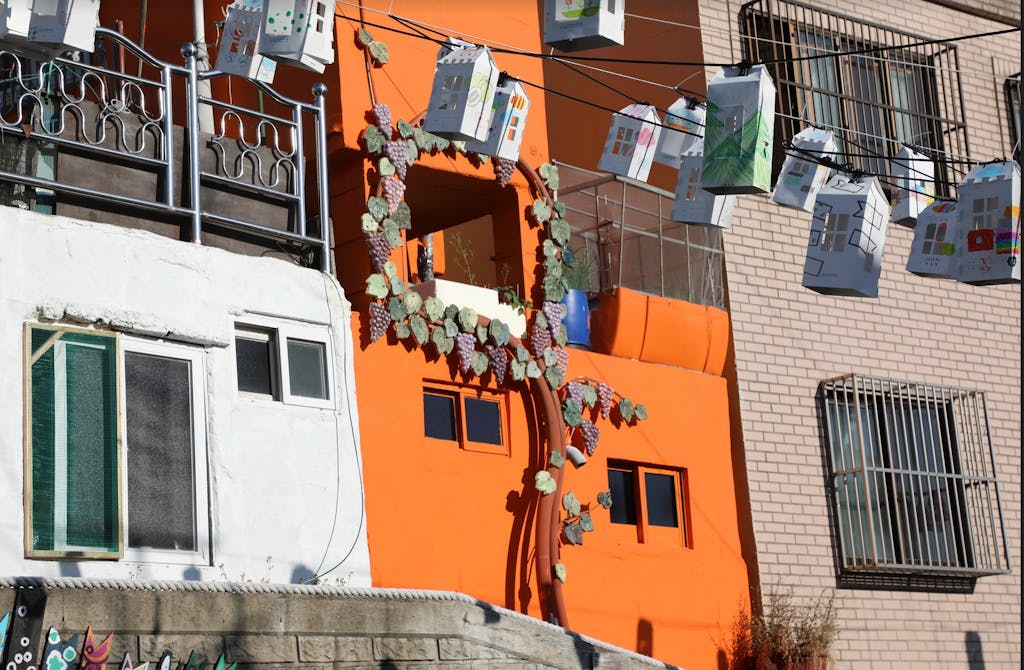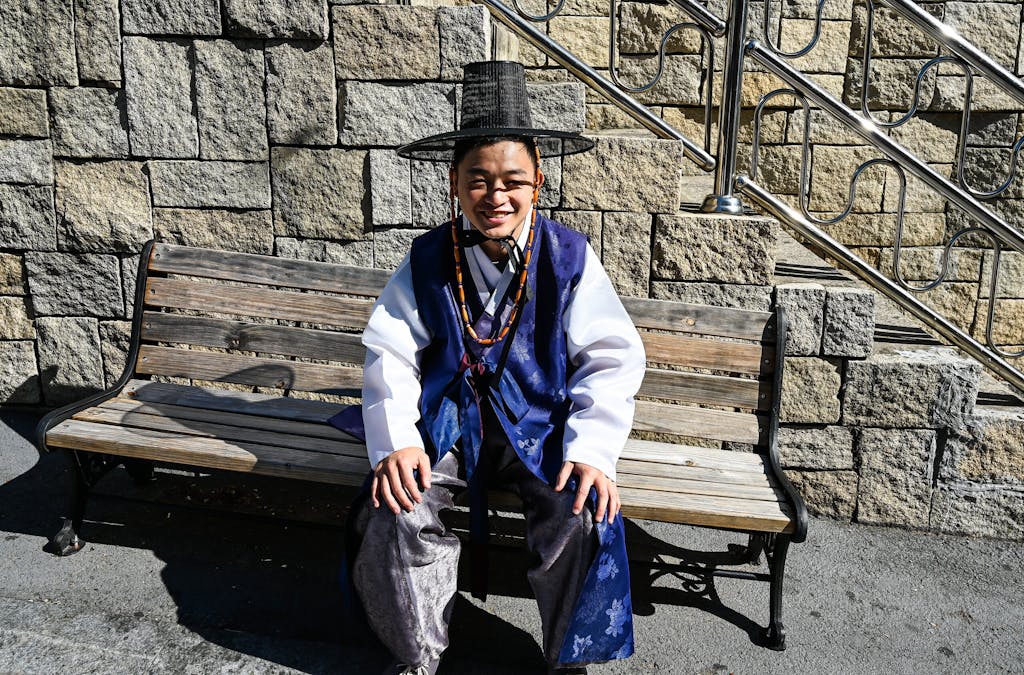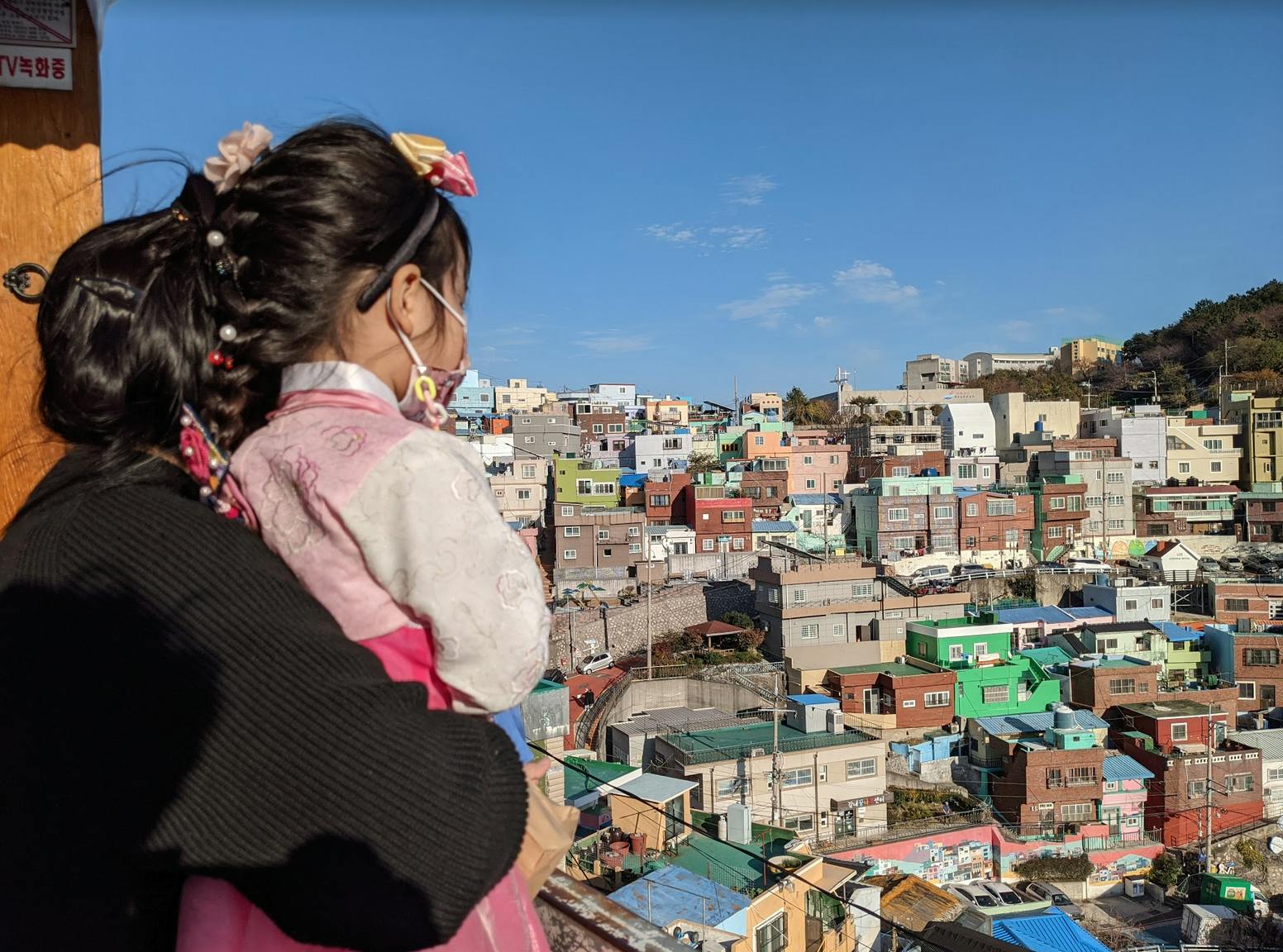Looking for Things to Do in Busan? Don’t Sleep on Color-Happy Gamcheon
If a child ever dumped a toy box of brightly-colored Legos into a steep mountain ravine, it might look something like Gamcheon Culture Village. Up close, the blocks turn into a dense mix of brightly-colored homes stacked along haphazard alleys — a dizzying pedestrian playground that may be the most playful neighborhood in South Korea, and one of the most fascinating things to do in Busan.
Thousands of pretty paper lanterns are strung over the main street, lighting up the gentle flowing path like a curving river down the mountainside. Hundreds of narrow passageways — short alleys, tight footpaths, and twisted downward steps — are laced together in a slanted labyrinth that begs visitors to take a detour and plunge into the mystery of Gamcheon. The dramatic geography makes it almost impossible to get lost, but no matter where I wander, I see something new and surprising.

The range of colors is astonishing, with solid little houses painted turquoise and lavender, cobalt blue with neon yellow trim, brick red with white trim, rust orange next-door to kelly green, or rose pink next to tangerine. Indeed, Gamcheon seems like a busy little paint box with an infinite palette, topped with metal roofs of blue, green, orange, and silver.
Even the smallest spaces are alive with color, decoration and growing bits of nature. Rooftop gardens flourish with potted plants and bursting flowers, growing year-round in the mild climate of Busan, Korea’s second-largest city.
Building for the good of the many

The quirky charm of today’s Gamcheon harks back to an urban history as unique as these unruly terraces. The steep ravine was first colonized in 1918 by several thousand followers of the Taekgeukdo (a syncretic religious movement vaguely linked to Taoism). Together, they built the nearly-vertical village according to their beliefs and with strong community traditions. When the Korean conflict ended in 1955, a new wave of refugees arrived and constructed a working hive of small cubic homes that cling to the abrupt slopes. In the spirit of equality, no house blocks the view of any other house, so that the resulting cityscape follows the curving contours like an organized jumble of rainbow-colored blocks.
Anywhere else in the world, such an adorable neighborhood as Gamcheon would be rapidly gentrified into condos or some gaudy shopping complex. But fortunately, the city of Busan has nobler priorities. In order to preserve the rich life of these narrow twisted streets, residents and local artists joined forces with religious leaders and city government to create the “Gamcheon Culture Village.”
The new designation represents a blend of artistic promotion with strong social programs that directly benefit the elderly residents. Considerate tourists are welcome to explore the colorful canyon of pastel homes and lantern-lit street — and all are encouraged to participate in the artistic expression and interactive fun.
A feast of fish

Today’s Gamcheon is a crucible of creativity with over a hundred artists’ workshops, as well as multiple design studios, funky craft shops, and more street art than you can discover in any given day as you decide what to do in Busan. Every few steps, my eyes catch the beautiful art installations (big and small) that fill up the brick walls and concrete corners. The immense outdoor art gallery is an open invitation to explore, and I loved stumbling into each piece on my own. My favorite was the magnificent “fish,” compiled from hundreds of decorated scrap boards, “swimming” down Jin Yeongseop alley.
Social media and mobile technology adds a sharable dimension to Gamcheon, with abundant interactive stations for creative selfies, and opportunities to expand the imagination with unique settings like a cartoonish red lighthouse or a multi-story open-air house dedicated to The Little Prince. But Gamcheon is not some childish amusement park — some of the biggest names in South Korea’s avant-garde architecture community have added their own original signature to Gamcheon. Featuring a pyramid-roof built from thousands of uniform wooden slats, Seung H-Sang’s “Tower of Solo Pleasure” becomes an ever-changing temple of natural light. Like Gamcheon itself, the architecture is experiential.
Going with the flow in Gamcheon

Taking part in the unexpected fun is what sets Gamcheon apart from traditional museums or tourist attractions, easily making it one of the best things to do in Busan. The working, breathing neighborhood is still home to a few thousand long-established residents who are living their daily lives as part of the whimsical spectacle. On a Sunday afternoon, I watch whole South Korean families casually float down the promenade, taking pictures, watching a street performer, pulling fortunes from wooden vending machine, or stopping to explore the incredible street food.
Gamcheon’s sense of wonder spills over into the treats on offer, from clear-jelly “glass” cakes to soft-serve ice cream cones whose flavors are as varied as cantaloupe and black licorice. Young people bite into fluffy balls of cotton candy, whirled into the shape of a bunny rabbit or dinosaur. I quickly lose count of the cute teahouses and cozy coffee shops that seem wedged into the precipitous slopes, filling the street with sweet aromas. I was finally conquered by the traditional Korean donuts, which are as different and dainty as the adorable houses of Gamcheon.

The marvelous blend of old and new adds to the rare magic of these tiny streets. Walking past groups of laughing local teenagers chatting with elderly residents, I see people dressed in the traditional hanbok (national dress). I also visit the hwahyejang — the only remaining Korean shoemaker in Busan, who employs ancient techniques in stitching traditional footwear from dyed silk.
Preserving some of the country’s oldest art forms is part of the lifestyle in the tucked-away hillside of Gamcheon — a stark contrast to the ultra-modern, skyscraper-high city of Busan with its 3.5 million people.
Good travel tends to shatter stereotypes, and a few minutes in Gamcheon will disprove any notion that South Korean culture is merely circumspect and reserved. Quite the contrary.
Gamcheon offers a reminder that life is fun and full of color. And, just like life, beauty and joy can flow out of the ups and downs, abundant diversity, and the freedom of individual expression. In this way, Gamcheon remains true to its Taoist roots, inviting everyone to walk their own path, make their own turns, and follow the invisible flow of the senses.
Above all, Gamcheon celebrates the idea of finding the balance in asymmetry, and that humans, with their art and engineering, are as much a part of nature as this confetti-strewn village at the edge of a mountain with the blue ocean that shines on the horizon.
Ready to experience Gamcheon and the other unique things to do in Busan? Start by browsing these Silversea cruises to Asia, many of which stop in South Korea.

